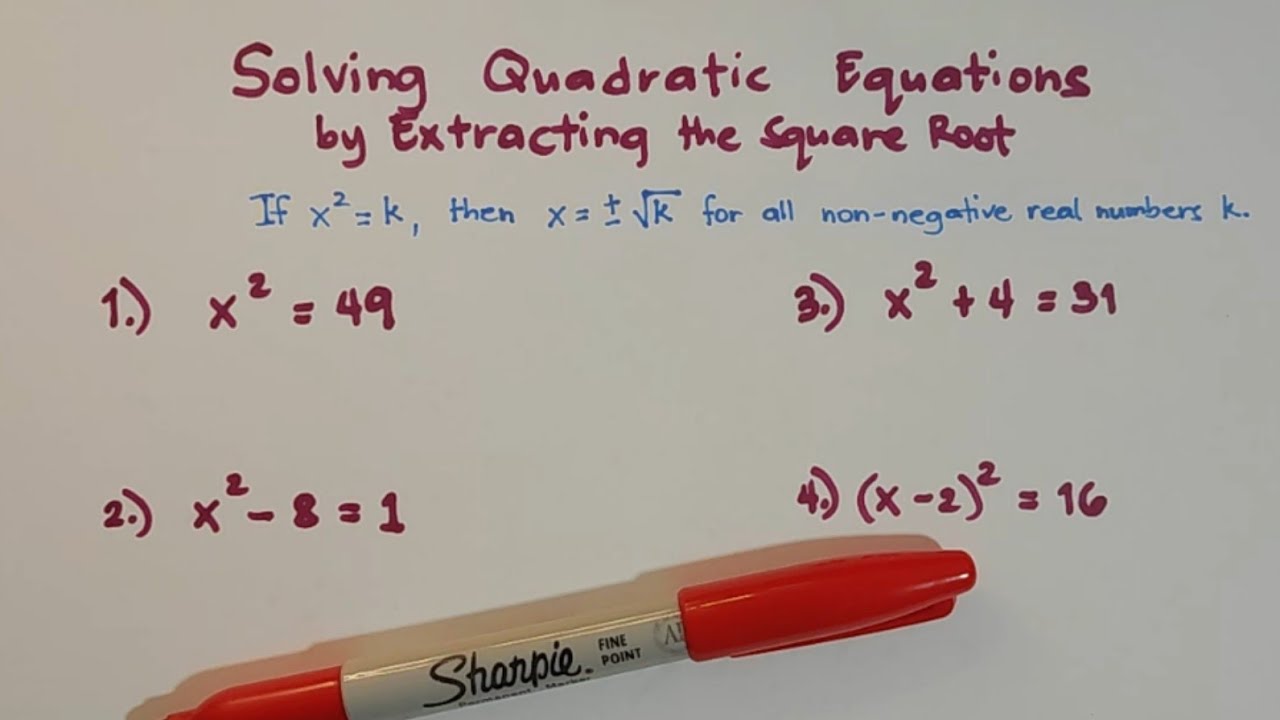How To Solve Quadratic Equations Using The Quadratic Formula
Summary
TLDRThis video tutorial offers a step-by-step guide on solving quadratic equations using the quadratic formula. It begins with an example equation, 2x^2 + 3x - 2 = 0, and demonstrates how to identify coefficients a, b, and c. The formula is then applied to find two possible solutions for x, which are verified by substituting back into the original equation. The process is repeated with a second example, showcasing the versatility of the quadratic formula. The video concludes by reinforcing the method's effectiveness in solving quadratic equations, encouraging viewers to practice and master this fundamental mathematical skill.
Takeaways
- 📚 The video is a tutorial on solving quadratic equations using the quadratic formula.
- 🔍 It begins with an example equation: 2x^2 + 3x - 2 = 0, aiming to find the values of x that satisfy the equation.
- 📝 The quadratic formula introduced is: x = -b ± √(b^2 - 4ac) / (2a).
- 📐 The terms a, b, and c are identified as coefficients in the quadratic equation: a is the coefficient of x^2, b is the coefficient of x, and c is the constant term.
- 🔢 The formula is applied to the example equation, with a = 2, b = 3, and c = -2.
- 🧩 The discriminant (b^2 - 4ac) is calculated, which determines the nature of the roots (real and distinct, real and equal, or complex).
- 📉 The discriminant in the example is found to be positive, indicating two distinct real roots.
- 📈 The roots are calculated to be x = 1/2 and x = -2, demonstrating the use of the plus-minus symbol in the formula.
- 🔄 The video suggests checking the solutions by substituting them back into the original equation.
- 📝 A second example is presented with a = 6, b = -17, and c = 12, to further illustrate the application of the formula.
- 🔑 The roots for the second example are found to be x = 3/2 and x = 4/3, showcasing the simplification of fractions.
- 👍 The video concludes by reinforcing the method for solving quadratic equations using the quadratic formula.
Q & A
What is the main topic of the video?
-The main topic of the video is how to solve quadratic equations using the quadratic formula.
What is the quadratic formula?
-The quadratic formula is used to solve quadratic equations and is given by \( x = \frac{-b \pm \sqrt{b^2 - 4ac}}{2a} \).
What are the coefficients a, b, and c in the context of the quadratic formula?
-In the quadratic formula, 'a' is the coefficient of \( x^2 \), 'b' is the coefficient of 'x', and 'c' is the constant term.
What is the first example equation given in the video?
-The first example equation given is \( 2x^2 + 3x - 2 = 0 \).
How are the values of a, b, and c determined for the first example equation?
-For the first example equation, 'a' is 2, 'b' is 3, and 'c' is -2, based on the standard form of a quadratic equation \( ax^2 + bx + c = 0 \).
What is the discriminant in the quadratic formula?
-The discriminant in the quadratic formula is the part under the square root, \( b^2 - 4ac \), and it determines the nature of the roots of the quadratic equation.
How many solutions does the first example equation have?
-The first example equation has two solutions, as indicated by the 'plus-minus' symbol in the quadratic formula.
What is the second example equation presented in the video?
-The second example equation is not explicitly given in the transcript, but it is described to have 'a' as 6, 'b' as -17, and 'c' as 12.
What is the purpose of the 'plus-minus' symbol in the quadratic formula?
-The 'plus-minus' symbol in the quadratic formula indicates that there are two possible solutions for 'x', one by adding the square root result to '-b' and the other by subtracting it.
How does the video demonstrate checking the solution of a quadratic equation?
-The video demonstrates checking the solution by plugging the found value of 'x' back into the original equation to see if it satisfies the equation, making the left-hand side equal to zero.
What is the final advice given in the video regarding solving quadratic equations?
-The final advice is that once you find the solutions using the quadratic formula, you can check your answers by plugging them back into the original equation.
Outlines

このセクションは有料ユーザー限定です。 アクセスするには、アップグレードをお願いします。
今すぐアップグレードMindmap

このセクションは有料ユーザー限定です。 アクセスするには、アップグレードをお願いします。
今すぐアップグレードKeywords

このセクションは有料ユーザー限定です。 アクセスするには、アップグレードをお願いします。
今すぐアップグレードHighlights

このセクションは有料ユーザー限定です。 アクセスするには、アップグレードをお願いします。
今すぐアップグレードTranscripts

このセクションは有料ユーザー限定です。 アクセスするには、アップグレードをお願いします。
今すぐアップグレード関連動画をさらに表示

PERSAMAAN KUADRAT part ZERO-ONE

Persamaan Kuadrat • Part 4: Menyelesaikan Persamaan Kuadrat dengan Rumus abc

How to Solve Quadratic Equations by Extracting the Square Root? @MathTeacherGon

Kwadratische vergelijkingen (HAVO wiskunde B)

Solving Quadratic Equation Using Quadratic Formula

Solving Equations Transformable into Quadratic Equations
5.0 / 5 (0 votes)
